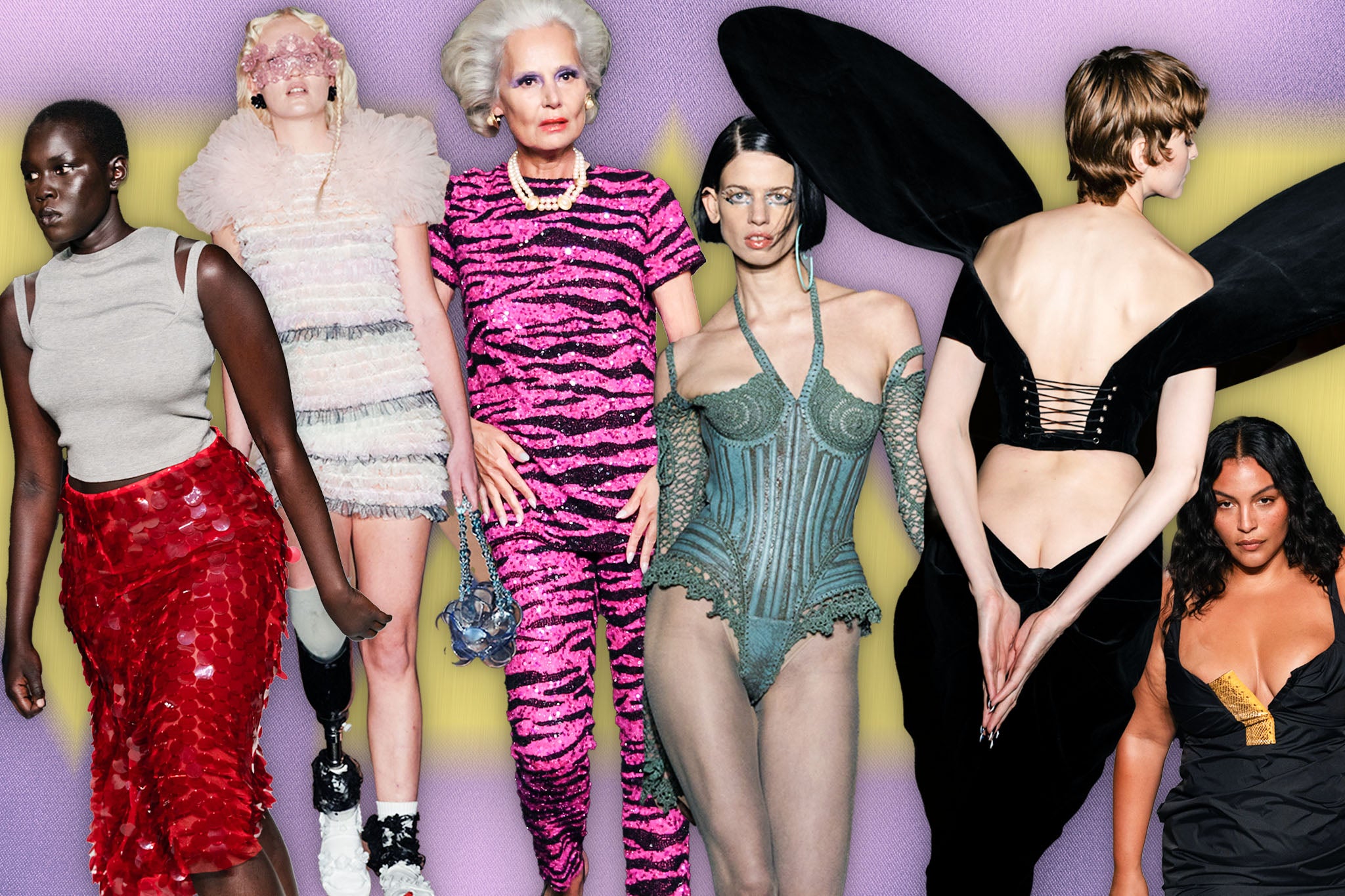Voguewashing London Fashion Week won’t pay the wages of Britain’s young fashion designers
As London Fashion Week draws to a close, Olivia Petter reflects on why our brilliant young creatives need more than Anna Wintour and a catwalk of A-listers from Stormzy to Sienna Miler riding into town to ‘save’ the day


The giveaway was that it started with a fundraiser. Although, if you’ve seen any of the photos from last week’s star-studded Vogue World, you’ll know that this was no bake sale. Featuring performances from FKA Twigs, Sienna Miller, Damian Lewis, Stormzy, and many, many more, the West End-inspired extravaganza was held to celebrate and raise money for the UK’s performing arts scene, which American Vogue editor-in-chief Anna Wintour described as “under threat”.
Ostensibly, it was a brilliant showcase of glamour attracting the likes of Kate Moss and Cara Delevingne, alongside Naomi Campbell, Christy Turlington, Linda Evangelista, and Cindy Crawford in a tribute to the original 1990s supermodels. And with the shows came A-list celebrities, with this year proving to be a vintage year for star spotting. But underneath all those blow-dries and bespoke designer ensembles was a very bleak reality: this is an industry in need of urgent life support.
It’s a tacit cry that has undercut almost every show on this season’s lineup, let alone those that didn’t quite make it onto the schedule at all. For spring/summer 2024, London has borne the brunt of a spate of absences, with key designers like Halpern, SS Daley, Rixo, Rejina Pyo, and Nensi Dojaka all taking some time out. Meanwhile, two former bright lights in the industry, Christopher Kane and Nicholas Kirkwood, filed for bankruptcy this year.
“I don’t think it has ever been more difficult to be an independent designer in London than it is at this moment,” said British Fashion Council chief Caroline Rush at a news conference last week. Indeed, as if Brexit didn’t make things difficult enough in terms of sourcing talent and materials abroad, then came the pandemic. And then there’s the cost of living crisis.
“Brexit created an obstacle for fashion designers that was not there before,” explains Bora Aksu, whose spring/summer 2024 collection debuted on Friday. “It has made everything slower; customs in Europe have become a huge problem, there are constant delays.”
Of course, all this has also affected consumer habits, too. “People don’t shop as much,” says Eudon Choi, whose collection showcased on Saturday. “It’s no surprise it’s becoming a bit of the norm for some brands to take a season off. They need to pause and re-evaluate. Having a consistent presence in LFW was really important before the pandemic but I think it’s changed now; it’s okay to take some time off to focus on creating better collections.”
No amount of star power, though, seems to immunise anyone against the current strains. Consider Dilara Findigolou, recently hailed by The New York Times as London’s “buzziest” young designer, who cancelled her show just days before. “I had to make a business decision to protect my business to sustain it in the long run,” the 33-year-old tells me. “The shows are an important part of what we do but they are extremely expensive and we need to make a decision that prioritises the longevity of the brand.”
This is despite the fact that Findikoglu earned global success this summer given her viral designs for Cardi B and Margot Robbie, who chose a fuchsia minidress by the designer for the Barbie premiere afterparty in London.
“This move may have surprised fans as the last show was our biggest yet and that was reflected in the reaction it received,” adds Findikoglu. “I think perhaps it’s the public perception of what it is like to run a brand versus the reality, which can be much tougher. But everyone has been really supportive about this decision and made me realise how big of a loyal community we’ve created and I’m really grateful for that.”
Even those who are showing, though, are facing challenges. Compare the front rows at London Fashion Week to those in Paris or Milan, where the lineup consists of major brands owned by conglomerates like LVMH and Kering, and the distinction is stark. The latter will be occupied by a much bigger presence of A-list Hollywood stars and musicians (sometimes paid upwards of £50,000 for their attendance) than is ever seen in London even when Anna Wintour is rallying the troops.

This is, in part, a reflection of London’s reputation as an incubator for new and emerging talents as opposed to upholding heritage brands. Household names may grab the headlines, but London has always been more about faces of the future that complement the innovation on the runways. We want to be shocked, disturbed, and challenged by British designers. “The creative industries are our superpower here in the UK”, Caroline Rush said. “And London is the best in class”. But how many boundaries can they really push if they can barely afford to ship their fabrics over from Europe? As much as we’d like to deny it, creativity often hinges on financial freedom, at least in the current climate.
There are other challenges beyond financial ones, too. Consider JW Anderson, one of the city’s most subversive talents who recently confessed to being afraid of getting cancelled. “You can’t have a conversation, or say what you feel without having to navigate this weird safety culture,” the designer told the Evening Standard. “And it is impacting creativity; you know, people like Rembrandt could not exist today, McQueen could not exist today.”
It was a sentiment echoed by Harris Reed, another one of the industry’s leading lights, who spoke of how casting trans and non-binary models in his show “runs the risk of turning off some of my Middle Eastern and Asian clients”, adding: “I walk a very fine balance of not offending too many people to equal sales and build my brand, but I still need to stand behind my messaging.”
Brexit created an obstacle for fashion designers that was not there before
This is not something limited to the UK. “I think the fashion industry as a whole is going through a very narrow path,” adds Aksu. “Striking a note between creating a collection that is true to the designer’s identity as well as including styles that are commercially successful is a tough balance that we all need to work on that people outside of the industry may not realise.”
Both Aksu and Reed’s collections were, nonetheless, a triumph. But it’s telling that one of the highlights of the latter was an homage to McQueen by way of a wing-structured, backless gown that dipped low into a bumster in a style that the late British fashion designer became renowned for.
There were nods elsewhere, too, like at KNWLS, which concluded with Lily McMenamy doing a vamped-up dance down the runway akin to those performed by McQueen models over the years when he was still alive. Something similar happened over at ASHISH, where models danced up and down the runway in a series of sultry moves quite unlike the usual deadpan stomp we’ve become accustomed to.
When it comes to fashion, the past is always going to inform the present. And while Vogue World’s show set was intended to celebrate all that is bright and bushy-tailed about the arts, it was ultimately an exercise in nostalgia, with a finale honouring the Nineties Supers.
But there has to be a balance; it’s an indictment of creativity if the pendulum is constantly swinging back.

Luckily, though there were a myriad of designers who were moving the needle and taking much-needed sartorial and aesthetic risks. At Matty Bovan, for example, who staged a 40-person dinner backstage to showcase his luminous collection, where every piece was created as a sculpture, featuring twists of upcycled fabrics bulging out in unexpected, garish silhouettes that outsized rather than flattered the female form. Then there was fashion set favourite 16Arlington, which featured several looks comprising oversized metal circles that rustled loudly as the models glided past, signalling their presence with dramatic flair. The wide range of bodies on display at Sinead O’Dwyer, Susan Fang and Chopova Lowena was refreshing.
All in all, there is still much to be hopeful for. “Despite the struggles, I still feel very positive about the industry,” says Choi. “There are new talents and names. London still has this really exciting energy. You can’t just get rid of that.” The hope now is that the industry gets the support it needs to build on that too.






Join our commenting forum
Join thought-provoking conversations, follow other Independent readers and see their replies
Comments